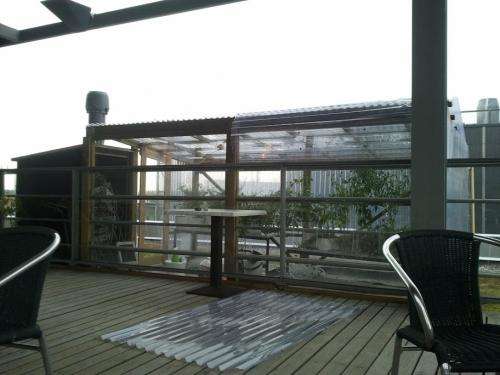Data centers can be cooled down in environmentally friendly, energy efficient ways

Data centers housing thousands of computers have enabled proliferation of new cloud-based services. One problem is their aggregate electricity consumption. Servers in data centers use electricity and generate heat, which endanger reliability of the services provided unless cooling is arranged. Mikko Pervilä defends his dissertation on retrofit cooling techniques for data centers in December. His study includes calculations for minimum energy savings achievable with the techniques. Pervilä also built a greenhouse running on exhaust heat on top of a building on Kumpula Campus.
Giant flagship data centers are actually more energy efficient than small computer facilities, Mikko Pervilä says.
Traditionally, computers have been cooled down with mechanical ventilation, resulting in additional electricity consumption. Many other maintenance systems associated with servers also require electricity. In addition to the energy spent on computing, this extra electricity negatively impacts the data centers' energy efficiency. Cloud services have proven to be so financially lucrative that the additional energy use has been considered an acceptable expense in relation to the value of the services.
Energy efficiency has become more of a focus lately from both an environmental standpoint and a financial one, as the price of electricity implies significant savings associated with lowered energy consumption. To maintain reliability, improving energy efficiency cannot result in service interruptions or lags for the end users.
Mikko Pervilä's doctoral thesis Data Center Energy Retrofits discusses the features of modern data centers through both case studies and global figures.
The individual case studies focus on the flagship facilities of major corporations, which are equipped to convince users of the companies' commitment to ecological responsibility. The global figures provide an overview of the common sizes of server rooms, and indicate that most server facilities are quite small and probably have poorer energy efficiency than the massive flagship data centers. According to Pervilä, major data centers such as those of Microsoft in Dublin and Quincy, Google in Saint-Ghislain and Hamina, Finland, Yahoo in Lockport, HP in Wynyard and Facebook in Prineville, are much alike, as they seek to minimise extraneous energy consumption by using adjacent natural cooling sources, such as bodies of water.
With these considerations in mind, the dissertation suggests a number of retrofit techniques for cooling data centers. These techniques range from the efficient delivery of ventilation air using free air cooling to exploiting exhaust heat in the experimental greenhouse on the Kumpula Science Campus in Helsinki, Finland.
The dissertation includes calculations for the minimum energy savings achievable with these techniques. For example, the amount of emissions reduced just by adopting free air cooling would be equivalent to 9.4 megatonnes of carbon dioxide based on the global electricity calculations from 2005. Global electricity consumption has increased since then, so the actual reduction would be correspondingly greater than in these calculations.
Provided by University of Helsinki
















